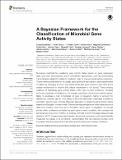A Bayesian Framework for the Classification of Microbial Gene Activity States

View/
Author
Disselkoen, Craig
Greco, Brian
Koch, Kristin
Viss, Chase
Cape, Joshua
Held, Elizabeth
Ashenafi, Yonatan
Fischer, Karen
Acosta, Allyson
Cunningham, Mark
Best, Aaron A.
DeJongh, Matthew
Tintle, Nathan
Note: Order does not necessarily reflect citation order of authors.
Published Version
https://doi.org/10.3389/fmicb.2016.01191Metadata
Show full item recordCitation
Disselkoen, C., B. Greco, K. Cook, K. Koch, R. Lerebours, C. Viss, J. Cape, et al. 2016. “A Bayesian Framework for the Classification of Microbial Gene Activity States.” Frontiers in Microbiology 7 (1): 1191. doi:10.3389/fmicb.2016.01191. http://dx.doi.org/10.3389/fmicb.2016.01191.Abstract
Numerous methods for classifying gene activity states based on gene expression data have been proposed for use in downstream applications, such as incorporating transcriptomics data into metabolic models in order to improve resulting flux predictions. These methods often attempt to classify gene activity for each gene in each experimental condition as belonging to one of two states: active (the gene product is part of an active cellular mechanism) or inactive (the cellular mechanism is not active). These existing methods of classifying gene activity states suffer from multiple limitations, including enforcing unrealistic constraints on the overall proportions of active and inactive genes, failing to leverage a priori knowledge of gene co-regulation, failing to account for differences between genes, and failing to provide statistically meaningful confidence estimates. We propose a flexible Bayesian approach to classifying gene activity states based on a Gaussian mixture model. The model integrates genome-wide transcriptomics data from multiple conditions and information about gene co-regulation to provide activity state confidence estimates for each gene in each condition. We compare the performance of our novel method to existing methods on both simulated data and real data from 907 E. coli gene expression arrays, as well as a comparison with experimentally measured flux values in 29 conditions, demonstrating that our method provides more consistent and accurate results than existing methods across a variety of metrics.Other Sources
http://www.ncbi.nlm.nih.gov/pmc/articles/PMC4977825/pdf/Terms of Use
This article is made available under the terms and conditions applicable to Other Posted Material, as set forth at http://nrs.harvard.edu/urn-3:HUL.InstRepos:dash.current.terms-of-use#LAACitable link to this page
http://nrs.harvard.edu/urn-3:HUL.InstRepos:29002698
Collections
- FAS Scholarly Articles [18292]
- SPH Scholarly Articles [6362]
Contact administrator regarding this item (to report mistakes or request changes)


